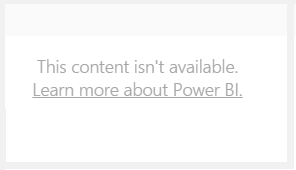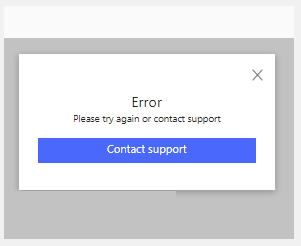您可以在報表上隱藏 Power BI 內嵌分析預設錯誤訊息,並改為顯示符合應用程式設計的自定義錯誤訊息。
例如,您可以取代這個預設錯誤對話框:

使用此自訂錯誤對話框:

如何覆寫錯誤
若要使用自定義錯誤訊息,請先將 hideErrors 屬性設定為 Power BI 內嵌分析組態物件中的 true,以隱藏預設的 Power BI 內嵌分析錯誤訊息。 此 powerbi.embed(element, config) 組態也包含其他設定和選項。 如需詳細資訊,請參閱 設定報表設定。
let config = {
type: 'report',
tokenType: models.TokenType.Embed,
accessToken: accessToken,
embedUrl: embedUrl,
id: embedReportId,
permissions: permissions,
settings: {
hideErrors: true
}
};
當您隱藏預設的錯誤訊息時,如果發生錯誤,錯誤對話框和訊息就不會再出現。 若要讓 app 的使用者在發生錯誤時取得一致且實用的回應,您必須負責處理錯誤事件。
若要處理錯誤,請先接聽 error 事件來取得錯誤:
report.off("error");
report.on("error", function(event) {
// Handle errors
});
IError 介面上的 level 屬性可讓您指定要處理的錯誤類型:
interface IError {
message: string;
detailedMessage?: string;
errorCode?: string;
level?: TraceType;
technicalDetails?: ITechnicalDetails;
}
enum TraceType {
Information = 0,
Verbose = 1,
Warning = 2,
Error = 3,
ExpectedError = 4,
UnexpectedError = 5,
Fatal = 6,
}
Fatal 錯誤是最嚴重的錯誤類型,因為它們會使報告沒有回應。 請務必處理 Fatal 錯誤,以防止終端使用者面對沒有回應或中斷的報告,而沒有任何錯誤訊息。
例
下列程式代碼範例示範如何藉由接聽和處理 error 事件來覆寫錯誤。 此範例不會顯示 newAccessToken 或 error.detailedMessage 函式。 實作指出的您自己的函式。
// Embed the loadConfiguration that hides the default errors.
let config = {
type: 'report',
tokenType: models.TokenType.Embed,
accessToken: accessToken,
embedUrl: embedUrl,
id: embedReportId,
permissions: permissions,
settings: {
hideErrors: true
}
};
// Get a reference to the embedded report HTML element.
let embedContainer = $('#embedContainer')[0];
// Embed the report and display it within the div container.
let report = powerbi.embed(embedContainer, config);
// Set report.off to remove any pre-existing error event handler.
report.off("error");
// Set report.on to add the new error event handler.
report.on("error", function(event) {
const error = event.detail;
// If the error level isn't Fatal, log the error and continue.
if (error.level !== models.TraceType.Fatal) {
console.error(error);
return;
}
// If the Fatal error is TokenExpired, refresh the token.
if (error.message === models.CommonErrorCode.TokenExpired) {
// Implement your own function here.
let newAccessToken = refreshToken();
// Set the new access token.
report.setAccessToken(newAccessToken);
} else {
// If the error isn't TokenExpired, show the custom
// dialog with detailed error message in the iframe.
// Implement your own function here.
showError(error.detailedMessage);
}
});